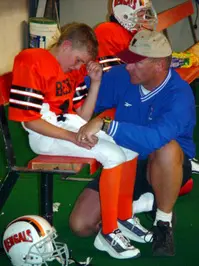
Dec 18, 2016 • 4 min read
I Think My Kid Has Concussion Symptoms. Now What? (1/3)
Posted in:
Part 1 of 3 – This post is by Paige Decker from the The Invisible Injury. In November of 2013, while playing for Yale’s Women’s Ice Hockey Team, she suffered a head injury that then only seemed minor. What she couldn’t have predicted then was that the next 22 months (and counting) would consist of a battle with a concussion so severe in its symptoms that it would go on to change her life forever.
 Concussion symptoms have been a serious topic of discussion in recent years, especially in the world of youth sports. I’ve been at the forefront of this issue since suffering a concussion of my own during my senior year on the Yale Women’s Ice Hockey team. Throughout this two-year long journey, I have learned a lot about concussions and launched a blog, The Invisible Injury, in September 2015 to share my experience. Based on what I’ve learned, I’ve put together a three-part concussion management guide to educate parents and coaches so they are empowered to protect their kids and know when to act.
Concussion symptoms have been a serious topic of discussion in recent years, especially in the world of youth sports. I’ve been at the forefront of this issue since suffering a concussion of my own during my senior year on the Yale Women’s Ice Hockey team. Throughout this two-year long journey, I have learned a lot about concussions and launched a blog, The Invisible Injury, in September 2015 to share my experience. Based on what I’ve learned, I’ve put together a three-part concussion management guide to educate parents and coaches so they are empowered to protect their kids and know when to act.
The 4R’s of concussion management
To begin, let’s review the 4R’s of concussion management, as advocated by one of the world’s leading concussion experts, Dr. Jeffery Kutcher:
1. Recognize the symptoms.
- If your child is behaving out of the ordinary, ask them how they’re feeling and if they remember bumping their head. Reach out to coaches, trainers or other parents to see if they recall a physical play in their child’s game that may have led to injury.
- Abnormal sleep patterns, moodiness, fogginess, difficulty focusing and complaints of headaches are all outward signs that your child may have suffered a brain injury.
2. Report to coach and/or trainer.
- The right individuals need to be notified immediately if a concussion is suspected. Individuals must be evaluated by a licensed medical professional in order to determine the extent of injury.
3. Remove from play.
- The brain is susceptible to further damage if it suffers a second blow to the head before the symptoms of the first have resolved. In rare cases, a condition known as Second Impact Syndrome can occur after this second blow, which leads to rapid and often fatal swelling of the brain. In order to prevent any further damage, remove them from play until a medical professional clears them for contact sports.
4. Recover before returning to play as assessed by ImPACT testing and symptoms.
- Typically the first step patients are asked to undergo for concussion recovery is cognitive rest. This means limiting brain activity as much as possible. Children should take a few days off from school and simply rest. Their brains need time to recover, and over-stimulating environments and increased brain activity will delay recovery and exacerbate symptoms.
- Avoid screens! No cell-phones, laptops or television.
- Take 1000 mg of fish oil per day. Fish oil is an omega-3 fatty acid that is great for brain health. It crosses the blood-brain barrier well and has components that make up the same building blocks beneficial in repairing the brain.
The 4R’s should function as behavioral guidelines when you think there’s a possibility that your child is exhibiting concussion symptoms. In conjunction with the above guidelines, Part II of this concussion management guide will discuss a few important steps that should be taken immediately to ensure children are better protected from concussions. Stay tuned!
Please see Part II or Part III of our concussion guide for further questions or contact us at concussions@leagueside.com.
